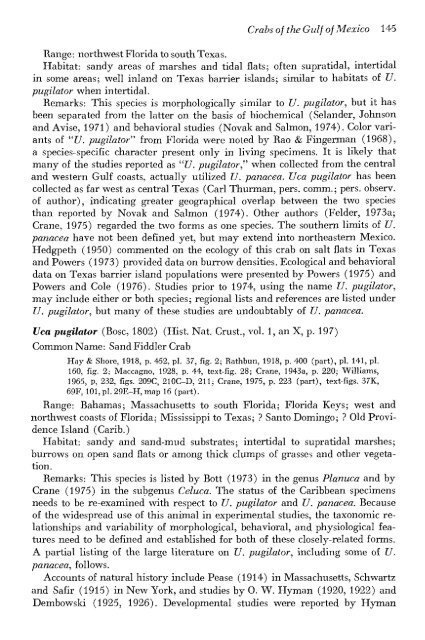Create successful ePaper yourself
Turn your PDF publications into a flip-book with our unique Google optimized e-Paper software.
Crabs of the Gulf of Mexico 145<br />
Range: northwest Florida to south Texas.<br />
Habitat: sandy areas of marshes and tidal flats; often supratidal, intertidal<br />
in some areas; well inland on Texas barrier islands; similar to habitats of Z7.<br />
pugilator when intertidal.<br />
Remarks: This species is morphologically similar to Z7. pugilator, but it has<br />
been separated from the latter on the basis of biochemical (Selander, Johnson<br />
and Aviso, 1971) and behavioral studies (Novak and Salmon, 1974). Color variants<br />
of "Z7. pugilator''' from Florida were noted b}"- Rao & Fingerman (1968),<br />
a species-specific character present only in living specimens. It is likely that<br />
many of the studies reported as "Z7. pugilator" when collected from the central<br />
and western Gulf coasts, actually utilized U. panacea. Uca pugilator has been<br />
collected as far west as central Texas (Carl Thurman, pers. comm.; pers. obseiT.<br />
of author), indicating greater geographical overlap between the two species<br />
than reported by Novak and Salmon (1974). Other authors (Felder, 1973a;<br />
Crane, 1975) regarded the two forms as one species. The southern limits of Z7.<br />
panacea have not been defined yet, but may extend into northeastern Mexico.<br />
Hedgpeth (1950) commented on the ecology of this crab on salt flats in Texas<br />
and Powers (1973) provided data on burrow densities. Ecological and behavioral<br />
data on Texas barrier island populations were presented by Powers (1975) and<br />
Powers and Cole (1976). Studies prior to 1974, using the name U. pugilator,<br />
may include either or both species; regional lists and references are listed under<br />
TJ. pugilator, but many of these studies are undoubtably of U. panacea.<br />
Vca pugilator (Bosc, 1802) (Hist. Nat. Crust., vol. 1, an X, p. 197)<br />
Common Name: Sand Fiddler Crab<br />
Hay & Shore, 1918, p. 452, pi. 37, fig. 2; Rathbun, 1918, p. 400 (part), pi. 141, pi.<br />
160, fig. 2; Maccagno, 1928, p. 44, text-fig. 28; Crane, 1943a, p. 220; Williams,<br />
1965, p, 232, figs. 209C, 210C-D, 211; Crane, 1975, p. 223 (part), text-figs. 37K,<br />
69F, 101,pI.29E-H,map 16 (part).<br />
Range: Bahamas; Massachusetts to south Florida; Florida Keys; west and<br />
northwest coasts of Florida; Mississippi to Texas; ? Santo Domingo; ? Old Providence<br />
Island (Carib.)<br />
Habitat: sandy and sand-mud substrates; intertidal to supratidal marshes;<br />
burrows on open sand flats or among thick clumps of grasses and other vegetation.<br />
Remarks: This species is listed by Bott (1973) in the genus Planuca and by<br />
Crane (1975) in the subgenus Celuca. The status of the Caribbean specimens<br />
needs to be re-examined with respect to U. pugilator and U. panacea. Because<br />
of the widespread use of this animal in experimental studies, the taxonomic relationships<br />
and variability of morphological, behavioral, and physiological features<br />
need to be defined and established for both of these closety-related forms.<br />
A partial listing of the large literature on U. pugilator, including some of TJ.<br />
panacea, follows.<br />
Accounts of natural history include Pease (1914) in Massachusetts, Schwartz<br />
and Safir (1915) in New York, and studies by 0. W. Hyman (1920, 1922) and<br />
Dembowski (1925, 1926). Developmental studies were reported by Hyman

















